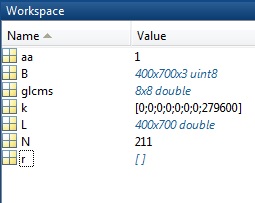In answers to this question on MATLAB Answers it is hinted that graycomatrix is a good way to solve this problem. However, those answers are incomplete.
graycomatrix requires several arguments to do what we need it to do. It computes a gray-value co-occurrence matrix. This is a matrix that says, in cell (i,j), how often a gray-value i occurs next to another gray-value j. The "next to" relationship can be defined in this function. By default, graycomatrix returns an 8x8 matrix, where it bins all gray-values in the image into 8 bins, and looks for any gray-value in group i occurring next to any gray-value in group j.
So we need to keep each label in our superpixel image separate in this co-occurrence matrix (there are N different labels, or gray-values). We also need to specify the "next to" relationship to be either [1,0] or [0,1], i.e. two pixels next to each other horizontally or vertically. When specifying two "next to" relations, we get two co-occurrence matrices back, in the form of a 3D matrix. Note also that the co-occurrence matrix is not symmetric, in our superpixel image, label i might happen to the left of label j, but in that case it is unlikely that j also happens to the left of i. Therefore, glcms(i,j) would have a non-zero count, but glcms(j,i) would be zero. In the code below we overcome this by explicitly making the matrix symmetric.
This is the code:
B = imread('kobi.png'); % using one of MATLAB's standard images
[L,N] = superpixels(B,200);
glcms = graycomatrix(L,'NumLevels',N,'GrayLimits',[1,N],'Offset',[0,1;1,0]);
glcms = sum(glcms,3); % add together the two matrices
glcms = glcms + glcms.'; % add upper and lower triangles together, make it symmetric
glcms(1:N+1:end) = 0; % set the diagonal to zero, we don't want to see "1 is neighbor of 1"
glcms is now the adjacency matrix. The value at glcms(i,j) is non-zero if superpixels i and j are neighbors. The value indicates how large the boundary between the two superpixels is.
To compute an adjacency list:
[I,J] = find(glcms); % returns coordinates of non-zero elements
neighbors = [J,I]



NumLevelsdidn't help at all? – Brueghel[glcms,SI] = graycomatrix(L,'NumLevels',N,'GrayLimits',[]);that N is the number of a superpixel that we want specify its neighbors, the error of "Index in position 3 exceeds array bounds (must not exceed 1)" occurs and that is related to the line ofk=glcms(:,:,20); %if you want to find neibours of 1,then input SupNum=1. – Urticaria